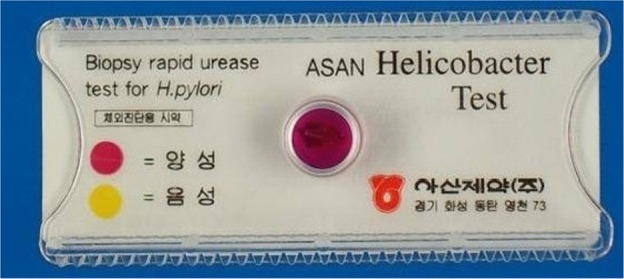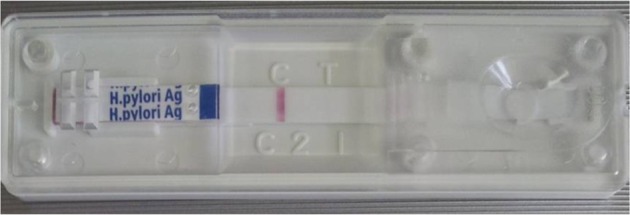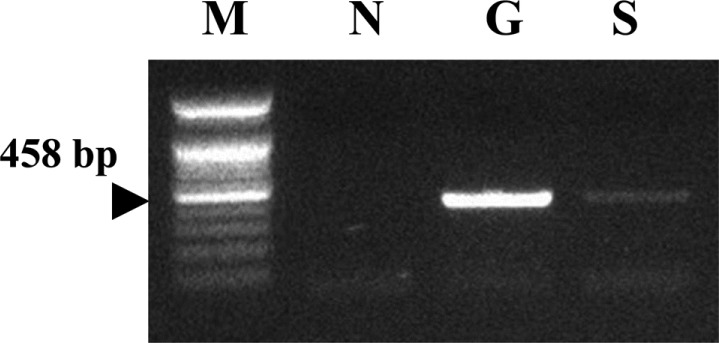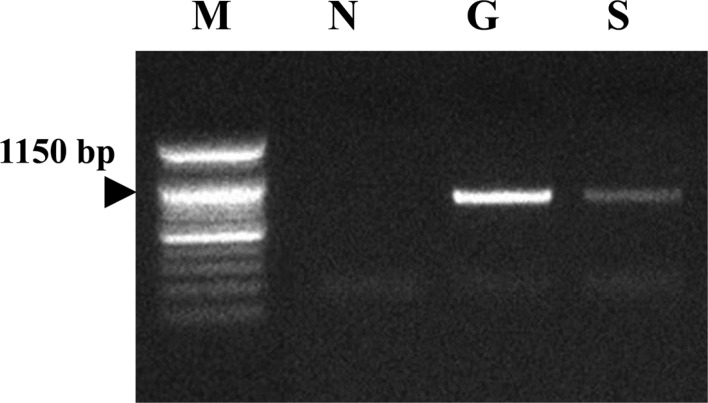Lab Anim Res.
2016 Jun;32(2):122-127. 10.5625/lar.2016.32.2.122.
Detection of Helicobacter felis in a cat with gastric disease in laboratory animal facility
- Affiliations
-
- 1Center for Animal Resource Development, Wonkwang University, 460 Iksandae-ro, Iksan, Korea. kimoj@wku.ac.kr
- 2Department of Companion Animal and Animal Resources Science, Joongbu University, 201 Daehakro, Geumsan-gun, Korea.
- 3Graduate School of Applied Animal Science, Wonkwang University, 460 Iksandaero, Iksan, Korea.
- KMID: 2309086
- DOI: http://doi.org/10.5625/lar.2016.32.2.122
Abstract
- A 3-month-old male cat in the animal facility was presented for investigation of anorexia and occasional vomiting. We collected the specimens from gastroscopic biopsy and stool collection. The gastroscopic biopsy specimens were tested using a rapid urease test, CLO Helicobacter-detection kits. Stool specimens were gathered and evaluated using the commercially available SD Bioline H. pylori Ag kit according to the manufacturer's instructions. Genomic DNAs from gastroscopic biopsy and stool specimens of the cat were extracted and submitted to the consensus PCR to amplify Helicobacter rpoB gene. Then the DNAs from gastroscopic biopsy and stool specimens were conducted a multiplex species-specific PCR to amplify urease B gene for H. heilmannii, H. pylori and H. felis. As the results, the rapid urease test with gastroscopic biopsy was revealed positive reaction. The result of H. pylori Stool Ag assay was one red line, negative for H. pylori. The gastroscopic biopsy and stool specimen were positive reactions by the consensus PCR reaction using the RNA polymerase beta-subunit-coding gene (rpoB) to detect Helicobacter species. By multiplex species-specific PCR with gastroscopic biopsy and stool specimens, no amplification products corresponding to either H. heilmannii or H. pylori were detected, but the specimens tested were positive for H. felis. This case was confirmed as gastroenteric disease induced by H. felis infection. On our knowledge, this is a very rare report about H. felis-induced gastroenteric disease in cat and may provide a valuable data on the study of feline Helicobacter infection.
Keyword
MeSH Terms
Figure
Reference
-
1. Fox JG. The non-H pylori helicobacters: their expanding role in gastrointestinal and systemic diseases. Gut. 2002; 50(2):273–283. PMID: 11788573.
Article2. Vandamme P, Falsen E, Pot B, Kersters K, De Ley J. Identification of Campylobacter cinaedi isolated from blood and feces of children and adult females. J Clin Microbiol. 1990; 28(5):1016–1020. PMID: 2191002.
Article3. Kim O. Helicobacter - An emerging new zoonotic pathogen. In : Lorenzo-Morales J, editor. Zoonosis. Rijeka, Croatia: InTec Press;2012. p. 89–100.4. Handt LK, Fox JG, Dewhirst FE, Fraser GJ, Paster BJ, Yan LL, Rozmiarek H, Rufo R, Stalis IH. Helicobacter pylori isolated from the domestic cat: public health implications. Infect Immun. 1994; 62(6):2367–2374. PMID: 8188360.
Article5. Fox JG, Batchelder M, Marini RP, Yan L, Handt LK, Li X, Shames B, Hayward A, Campbell J, Murphy JC. Helicobacter pylori-induced gastritis in the domestic cat. Infect Immun. 1995; 63(7):2674–2681. PMID: 7790084.
Article6. Geyer C, Colbatzky F, Lechner J, Hermanns W. Occurrence of spiral-shaped bacteria in gastric biopsies of dogs and cats. Vet Rec. 1993; 133(1):18–19. PMID: 8362485.
Article7. Andersen LP, Nørgaard A, Holck S, Blom J, Elsborg L. Isolation of a "Helicobacter heilmanii"-like organism from the human stomach. Eur J Clin Microbiol Infect Dis. 1996; 15(1):95–96. PMID: 8641315.
Article8. Solnick JV, O'Rourke J, Lee A, Paster BJ, Dewhirst FE, Tompkins LS. An uncultured gastric spiral organism is a newly identified Helicobacter in humans. J Infect Dis. 1993; 168(2):379–385. PMID: 8335974.
Article9. Solnick JV, O'Rourke J, Lee A, Tompkins LS. Molecular analysis of urease genes from a newly identified uncultured species of Helicobacter. Infect Immun. 1994; 62(5):1631–1638. PMID: 8168924.
Article10. Mégraud F. The most important diagnostic modalities for Helicobacter pylori, now and in the future. Eur J Gastroenterol Hepatol. 2012; 9(Suppl 1):S13–S15. PMID: 22498901.
Article11. Leal YA, Flores LL, Fuentes-Pananá EM, Cedillo-Rivera R, Torres J. 13C-urea breath test for the diagnosis of Helicobacter pylori infection in children: a systematic review and meta-analysis. Helicobacter. 2011; 16(4):327–337. PMID: 21762274.
Article12. Nyan DC, Welch AR, Dubois A, Coleman WG Jr. Development of a noninvasive method for detecting and monitoring the time course of Helicobacter pylori infection. Infect Immun. 2004; 72(9):5358–5364. PMID: 15322033.13. Santos AM, Lopes T, Oleastro M, Chaves P, Cordeiro R, Ferreira M, Pereira T, Machado J, Guerreiro AS. Role of 13C-urea breath test in experimental model of Helicobacter pylori infection in mice. Helicobacter. 2011; 16(4):320–326. PMID: 21762273.
Article14. Neiger R, Dieterich C, Burnens A, Waldvogel A, Corthésy-Theulaz I, Halter F, Lauterburg B, Schmassmann A. Detection and prevalence of Helicobacter infection in pet cats. J Clin Microbiol. 1998; 36(3):634–637. PMID: 9508286.15. Kim S, Cho S, Kim O. Detection and identification of secreting Helicobacter species from cats. Lab Anim Res. 2006; 22(3):243–247.16. Monteiro L, Bonnemaison D, Vekris A, Petry KG, Bonnet J, Vidal R, Cabrita J, Mégraud F. Complex polysaccharides as PCR inhibitors in feces: Helicobacter pylori model. J Clin Microbiol. 1997; 35(4):995–998. PMID: 9157172.
Article17. Moon DI, Shin EH, Oh HG, Oh JS, Hong S, Chung Y, Kim O. Usefulness of a Helicobacter pylori stool antigen test for diagnosing H. pylori infected C57BL/6 mice. Lab Anim Res. 2013; 29(1):27–32. PMID: 23573105.18. Shimoyama T. Stool antigen tests for the management of Helicobacter pylori infection. World J Gastroenterol. 2013; 19(45):8188–8191. PMID: 24363508.19. Patel SK, Pratap CB, Jain AK, Gulati AK, Nath G. Diagnosis of Helicobacter pylori: what should be the gold standard? World J Gastroenterol. 2014; 20(36):12847–12859. PMID: 25278682.20. Mapstone NP, Lynch DA, Lewis FA, Axon AT, Tompkins DS, Dixon MF, Quirke P. Identification of Helicobacter pylori DNA in the mouths and stomachs of patients with gastritis using PCR. J Clin Pathol. 1993; 46(6):540–543. PMID: 8331177.
Article21. Lee A, Hazell SL, O'Rourke J, Kouprach S. Isolation of a spiral-shaped bacterium from the cat stomach. Infect Immun. 1988; 56(11):2843–2850. PMID: 3169989.
Article22. Handt LK, Fox JG, Stalis IH, Rufo R, Lee G, Linn J, Li X, Kleanthous H. Characterization of feline Helicobacter pylori strains and associated gastritis in a colony of domestic cats. J Clin Microbiol. 1995; 33(9):2280–2289. PMID: 7494015.
Article23. Morris A, Nicholson G, Lloyd G, Haines D, Rogers A, Taylor D. Seroepidemiology of Campylobacter pyloridis. N Z Med J. 1986; 99(809):657–659. PMID: 3463897.24. Webb PM, Knight T, Elder JB, Newell DG, Forman D. Is Helicobacter pylori transmitted from cats to humans? Helicobacter. 1996; 1(2):79–81. PMID: 9398882.
Article25. Eaton KA, Dewhirst FE, Paster BJ, Tzellas N, Coleman BE, Paola J, Sherding R. Prevalence and varieties of Helicobacter species in dogs from random sources and pet dogs: animal and public health implications. J Clin Microbiol. 1996; 34(12):3165–3170. PMID: 8940465.
Article26. Hoshina S, Kahn SM, Jiang W, Green PH, Neu HC, Chin N, Morotomi M, LoGerfo P, Weinstein IB. Direct detection and amplification of Helicobacter pylori ribosomal 16S gene segments from gastric endoscopic biopsies. Diagn Microbiol Infect Dis. 1990; 13(6):473–479. PMID: 1703940.
Article27. Demirturk L, Yazgan Y, Tarcin O, Ozel M, Diler M, Oncul O, Yildirim S. Does N-acetyl cystein affect the sensitivity and specificity of Helicobacter pylori stool antigen test? Helicobacter. 2003; 8(2):120–123. PMID: 12662379.28. Malfertheiner P, Megraud F, O'Morain CA, Atherton J, Axon AT, Bazzoli F, Gensini GF, Gisbert JP, Graham DY, Rokkas T, El-Omar EM, Kuipers EJ. European Helicobacter Study Group. Management of Helicobacter pylori infection--the Maastricht IV/Florence Consensus Report. Gut. 2012; 61(5):646–664. PMID: 22491499.29. Rautelin H, Lehours P, Megraud F. Diagnosis of Helicobacter pylori infection. Helicobacter. 2003; 8(Suppl 1):13–20. PMID: 14617213.
Article30. Lee H, Park Y, Kim O. Prevalence of Helicobacter Species in Feces of Dogs using Polymerase Chain Reaction Analysis. Lab Anim Res. 2007; 23(3):339–344.
- Full Text Links
- Actions
-
Cited
- CITED
-
- Close
- Share
- Similar articles
-
- Evaluation of assays to detect Helicobacter felis infection in cats
- Postpartum Transmission as a Major Route of Mother-to-Child Helicobacter felis Infection
- Comparison of three diagnostic assays for the identification of Helicobacter spp. in laboratory dogs
- Effect of N-Methyl-N-Nitrosourea on Helicobacter-induced Gastric Carcinogenesis in C57BL/6 Mice
- Survey of Helicobacter infection in domestic and feral cats in Korea





